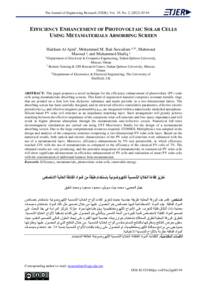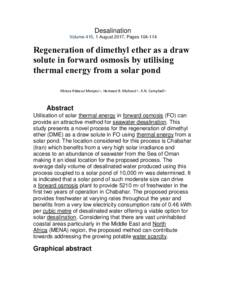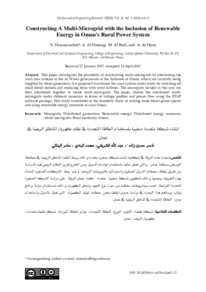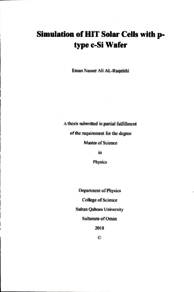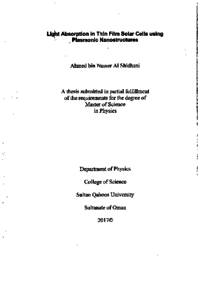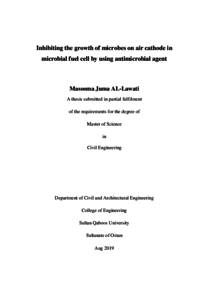Document
Design and simulation of dispatchable hybrid wind-PV power plant control scheme.
Identifier
Al-Busaidi, Mohammed Issa Saleh (2021). Design and simulation of dispatchable hybrid wind-PV power plant control scheme (Master thesis, Sultan Qaboos University, Muscat, Oman).
Publisher
Sultan Qaboos University.
Gregorian
2021
Language
English
Subject
English abstract
Renewable energy (RE) generation systems deployment is rapidly increasing globally,
offering major advantages of reducing fossil fuel consumption and lowering greenhouse
gas emissions to the environment. Renewable energy is by nature a sustainable resource
which can prove cheaper energy production cost in the long term and enhance energy
security. The recent development of renewable energy technologies showed a declining
trend in terms of cost and advancement in the integration of RE resources to the existing
power systems.
The target of the electricity generation expansion plan in Oman is to reduce the
dependency on natural gas as fuel and accommodate the Government's new fuel
diversification policy. In Oman 2040 Vision, the future strategy in natural resource
management will focus on developing non-traditional sources of natural resources, such
as the use of renewable energy to reduce production cost and subsequently enhance the
competitiveness of economic sectors. This objective aims to achieve 20% of renewable
energy consumption compared with total consumption by 2030 and 35% to 39% by 2040.
Oman benefits from a long coastline and exposure to the strong summer and winter
monsoon winds. It has an average wind speed slightly over 5 m/s and an estimated 2463
hours of full load per year, making the wind power an economically viable form of
renewable energy. On the other hand, Oman has a high ratio of "sky clearness" and
receives extensive daily solar radiation. This makes Oman eligible for utilizing wind and
solar energy as a sustainable and alternative source of energy.
However, integrating Wind and PV economically into a conventional power grid
necessitates the elimination of the complications caused by the intermittent behaviour of
these resources.
v
Here comes the need to aggregate the output of wind turbines with the PV system and
integrate the energy storage system (ESS) to waive the intermittency of Wind-PV and
balance power generation. The hybrid Wind-PV-ESS Power Plant with a proper energy
management system and well-designed control structure can achieve dispatchable RES,
hence, improve the system reliability, reduce the intermittency of supply, and enhance the
system security. The ESS can store extra produced energy and use it to compensate for
the reduction in power generation and balance out the fluctuations of the wind-PV power
in short and long periods. Additionally, the energy storage devices have a faster response
to handle load variations and generation fluctuations as well as achieving a robust and
dispatchable plant.
To achieve this approach, a well-designed control system scheme must be constructed to
connect all the components with each other and coordinate their operation. This thesis
presents the proposed control system scheme along with its simulations and results
analysis.
Member of
Resource URL
Arabic abstract
يتزايد نشر أنظمة توليد الطاقة المتجددة بسرعة على مستوى العالم، مما يوفر مزايا رئيسية لتقليل استهلاك الوقود الإحفوري وخفض انبعاثات الغازات الضارة للبيئة. الطاقة المتجددة هي بطبيعتها مورد مستدام يمكن أن يثبت تكلفة إنتاج طاقة أرخص على المدى الطويل ويعزز أمن الطاقة. أظهر التطور الإخير لتقنيات الطاقة المتجددة معدالت انخفاض من حيث التكلفة والتقدم في دمج موارد الطاقة المتجددة في أنظمة الطاقة الحالية. الهدف من خطة التوسع في توليد الكهرباء في عمان هو تقليل الإعتماد على الغاز الطبيعي كوقود واستيعاب سياسة الحكومة الجديدة لتنويع مصادر الطاقة. تخطط الحكومة العمانية لتحقيق 20 %من حصة الطاقة المتجددة من توليد الكهرباء بحلول عام 2030 وما بين 35 %إلى 39 %بحلول عام 2040 حسب رؤية عمان 2040 .تمتلك سلطنة عمان سواحل بحرية شاسعة وتتعرض لرياح رياح موسمية صيفية وشتوية قوية. حيث ان متوسط سرعة الرياح يزيد قليالً عن 5 م / ث وما يقدر بـ 2463 ساعة من الحمل الكامل كل عام، مما يجعل طاقة الرياح مصدراً صال ًحا للطاقة المتجددة. ومن ناحية أخرى، تتمتع عمان بنسبة عالية من "صفاء السماء" وتتلقى أشعة شمسية يومية واسعة النطاق. وهذا يجعل عمان مؤهلة الستخدام طاقة الرياح والطاقة الشمسية كمصدر مستدام وبديل للطاقة . ومع ذلك، فإن دمج طاقة الرياح والطاقة الكهروضوئية اقتصاديًا في شبكة الطاقة التقليدية يستلزم التخلص من المضاعفات التي يسببها السلوك المتقطع لهذه الموارد. ومن هنا تأتي الحاجة إلى تجميع توربينات الرياح مع النظام الكهروضوئي ودمج نظام تخزين الطاقة (ESS (للتقليل من تأثير تقطع انتاج طاقة الرياح وانتاج الخاليا الكهروضوئية والوصول الى توازن في توليد الطاقة. يمكن لمحطة توليد الطاقة الهجينة ESS-PV-Wind مع نظام إدارة الطاقة )EMS )المناسب وهيكل التحكم المصمم جيدًا تحقيق نظام طاقة متجددة قابل لإلسهام في توزيع الإحمال، وبالتالي تحسين موثوقية النظام وتقليل التقطع في الإمداد وتعزيز أمان النظام. كما يمكن لـلبطاريات المدمجة تخزين الطاقة المنتجة الفائضة واستخدامها للتعويض عن انخفاض توليد الطاقة وموازنة تقلبات طاقة الرياح الكهروضوئية في الفترات القصيرة والطويلة. بالإضافة إلى ذلك، تتمتع أجهزة تخزين الطاقة )البطاريات( باستجابة أسرع للتعامل مع تباينات الإحمال وتقلبات التوليد بالإضافة إلى إنشاء محطة قوية وقابلة لتوزيع الإحمال ومحاكاة عمل محطات انتاج الكهرباء التقليدية.
Category
Theses and Dissertations


